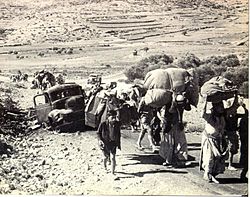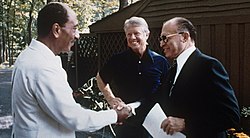Egypt–Israel peace treaty

The Egypt–Israel peace treaty was a peace treaty between Egypt and Israel. It was signed by both countries in 1979, at the end of the Camp David Accords. It was the first treaty between a Middle-Eastern Arab nation and Israel. After signing it, Egypt was removed from the Arab League.
The Egypt–Israel treaty was signed by Egyptian president Anwar Sadat and Israeli prime minister Menachem Begin, and witnessed by United States president Jimmy Carter.[1]
Background
After Gamal Abdel Nasser's death, Anwar Sadat became president, and Egypt's nationalist and Pan-Arabist politics changed. Sadat wanted to sign a peace treaty with Israel. After the Yom-Kippur War of 1973, he first made a state visit to Israel and officially recognised the country. Then, encouraged by the United States and Jimmy Carter, both sides secretly met at Camp David.[2]
The Arab-Israeli War of 1948
In 1947, the United Nations announced the Partition Plan for Palestine, which planned to divide Mandatory Palestine into different parts for Arabs and Jews.[3][4] Many people were unhappy with this solution, and so a civil war broke out between the different religious communities.[5]
When the British Mandate of Palestine ended and the State of Israel was founded on May 14, 1948, some Arab countries that were part of the Arab League attacked the young country. Among them were Syria, Egypt, and Jordan.[6] Many believed it had been built on Palestinian territory without permission.
The Arab-Israeli War ended with Israeli victory in January 1949. More than 18,000 people died in the many clashes.[7] In Israel, the war is called "War of Independence." In contrast, Palestinians often call it "Nakba", which means catastrophe.[8][9] More than 750,000 Palestinians were forced to leave their homes and lost everything.[10] Today, there are more than 7 million Palestinian refugees in the world.
Suez Crisis of 1956-57
In the early 1950s, Egypt's president Gamal Abdel Nasser and his government planned to build a new dam in the country. They needed money, which they hoped to get from other countries. However, the United States and Great Britain did not support this project because of Egypt's connections to communist countries.[11]
Nasser then decided to nationalise the Suez Canal in 1956 to earn profits from tolls. Britain and France, the countries that owned the Suez Company, were unhappy with this decision: they were afraid to lose control and to be cut off from the oil supply. They allied with Israel, whose government wanted to use the canal as well but couldn't because of continuous tensions.[11]
On October 29, 1956, the Israeli army invaded Egypt and gained control of Gaza. Britain and France then demanded a ceasefire as planned, and their troops occupied the canal in November.[11]
This conflict happened during the Cold War. To avoid a conflict between the East and the West, the UN, the United States of America, and the Soviet Union urged all foreign troops to leave Egypt. British and French forces left in December, but Israel occupied the area until March 1957.[12][13]
The European powers lost control in the region, while the Soviet Union gained influence in many Middle-Eastern countries. President Nasser and Egypt were the winners in this war, and this led to stronger feelings of nationalism in the region.[11]
Six-Day War of 1967
The different wars and continuing conflict between Israel and Egypt led to the Six-Day War on June 5, 1967. Israel attacked Egyptian positions in the air and on land. The soldiers captured the Gaza Strip, the Sinai Peninsula, the West Bank, and the Golan Heights. They took control of the whole city of Jerusalem on June 7.[14] This was especially important because Jerusalem as a holy city represented an important symbol for religion and nationalism.
The war lasted six days, until June 10, 1967. More than 20,000 Egyptian and 800 Israeli soldiers died in the battles. Because of Israel's victory and expansions, President Nasser resigned but soon returned to office. The war and Israel's new territories made the conflict worse.[14]
The Yom-Kippur War of 1973
The Yom-Kippur War began during the festivities of Yom Kippur and Ramadan, which are holy periods in Judaism and Islam. On October 6, 1973, Egypt and Syria attacked the territories Israel had won during the Six-Day War. Their forces quickly conquered the Sinai Peninsula and the Golan Heights. Because of the holiday, the Israeli army was not prepared. When Israel reacted, it took back control over the territories, and moved into Egypt and Syria.[15][16]
The United States of America were on Israel's side and supplied weapons, while Egypt and Syria were supported by the Soviet Union. This proxy war was dangerous, because it could have led to a conflict between the United States and the Soviet Union. On October 25, 1973, the war ended with a ceasefire.[17][18]
The Camp David Accords
The Camp David Accords were the agreements made after the secret Camp David talks at the President of the United States' country retreat on September 17, 1978. The talks between Israel and Egypt lasted 12 days, until both sides agreed on certain terms. President Carter was a leading force for the agreements, and these accords led to the Egypt-Israel Peace Treaty in 1979.[19]
First agreement
The first agreement focused on "A Framework for Peace in the Middle East", which was supposed to end the conflict between Israel and its neighbours. It also tried include the Palestinian problem. However, the agreement failed, because both parties, Egypt and Israel, interpreted it differently. It did not answer the Palestinian question and created room for conflict.[2]
Second agreement
The second agreement focused on "A Framework for the Conclusion of a Peace Treaty between Egypt and Israel", stating that the signing countries would enter a peace treaty with each other. This also meant that Egypt would receive back its lands in the Sinai Peninsula, but the country had to partially demilitarise. Israel would be allowed to use the Suez Canal. The agreement made sure the countries recognised each other.[19]
Aftermath
The peace treaty meant Egypt officially recognised Israel. Because of this, many Arab countries doubted if Egypt was still fighting for the Palestinian cause. By April 1979, nine Arab countries did not have diplomatic relations to the country.[20]
Several Arab countries also sanctioned Egypt, stopped economic aid, and boycotted Egyptian goods. Egypt was suspended from the Arab League, and the organisation's headquarters were moved out of the country. 10 years later, in 1989, the country became a member of the Arab League again.[20] The peace treaty formally ended the conflict between Egypt and Israel. There have been no wars between the countries since 1979. This has led to a decrease of military spending in Egypt. Since signing the treaty, Egypt and Israel have become trade partners.[21]
For their role in making peace between their countries, Anwar Sadat and Menachem Begin received the Nobel Peace Prize in 1978.[22] Sadat was later assassinated in 1981 by Egyptian soldiers, who saw the treaty as an act of betrayal.[23]
The Peace Treaty
On March 26, 1979, Egypt's president Anwar Sadat and Israel's prime minister Menachem Begin signed a peace treaty at the White House in Washington, D.C.. The President of the United States, Jimmy Carter, was also present. He had helped the relations between the countries. The treaty ended the war between Egypt and Israel. It included an agreement to end the conflict and three major points: the determination of final lines and zones, a promise of good relations between the two countries, and the problem of Palestinian autonomy. However, the problem of Palestinian autonomy remained unanswered.
Lines and zones
The Sinai Peninsula was divided into four zones, A, B, C, and D.
Zones A, B, and a part of Zone C were controlled by Egypt. Here, 22,000 soldiers and 248 tanks could be stationed. The rest of Zone C was under the control of the United Nations. Zone D was controlled by Israel, and could contain up to 4,000 personnel.[24]
The problem of Palestinian autonomy
The problem of Palestinian autonomy was not solved with the peace treaty. Egypt and Israel agreed that Palestinians would become independent when a "self-governing authority has been freely elected".[24] This meant that the Palestinian fate was still not secured.
Because Egypt signed the peace treaty, the most powerful Arab state had left the Arab-Israeli conflict. As the strongest among them was no longer fighting, many Arab states ended their active fight for Palestinian independence.[25]
Promises of good relations between both countries
The peace treaty officially ended the war between Israel and Egypt, the first Arab country to officially recognise Israel.[26]
Israel agreed to remove its armed forces from the Sinai Peninsula. In return, Egypt gave the country free access to the Suez Canal and agreed to build good relations with Israel.[24] Egypt also started receiving several billions of US-dollars from the United States for military goods and the economy.[27]
Egypt–Israel Peace Treaty Media
Menachem Begin, Jimmy Carter and Anwar Sadat at Camp David, 1978.
References
- ↑ Vance, Cyrus R.; Dayan, M. (1979). "The Egyptian-Israeli Peace Treaty". Middle East Journal. 33 (3): 327–347. ISSN 0026-3141.
- ↑ 2.0 2.1 Bani Salameh, Mohammed Abdul Rahman; Bani Salameh, Mohammed Torki; Al-Shra'h, Mohammad Kanoush (2012). "The Camp David Accords: Lessons and Facts" (PDF). The Arab Journal for Arts. 12 (2A): 41–66.
- ↑ "What was Mandatory Palestine? And why does it matter?" (in en). Time. 2014-09-29. https://time.com/3445003/mandatory-palestine/. Retrieved 2023-05-14.
- ↑ United Nations (1947). United Nations Special Committee on Palestine. Volume 1 : report to the General Assembly, 1947 (Report). United Nations. Retrieved 2023-05-14.
- ↑ "Milestones: 1945–1952 - Office of the Historian". history.state.gov. Retrieved 2023-05-14.
- ↑ "Arab nations Attack Israel - UPI Archives". UPI. Retrieved 2023-05-14.
- ↑ Sabel, Robbie (2022). International Law and the Arab-Israeli Conflict. Cambridge University Press. pp. 135. ISBN 9781108762670.
- ↑ AbuZayyad, Ziad (2008). "Nakba and Independence: Two Sides of the Same Coin". Palestine-Israel Journal. 15 (2): 4.
- ↑ Falah, Ghazi (1996). "The 1948 Israeli-Palestinian War and Its Aftermath: The Transformation and De-Signification of Palestine's Cultural Landscape". Annals of the Association of American Geographers. 86 (2): 258. doi:10.1111/j.1467-8306.1996.tb01753.x. JSTOR 2564005.
- ↑ Pappé, Ilan (2006-10-01). "The 1948 Ethnic Cleansing of Palestine". Journal of Palestine Studies. 36 (1): 6–20. doi:10.1525/jps.2006.36.1.6. hdl:10871/15208. ISSN 0377-919X.
- ↑ 11.0 11.1 11.2 11.3 "Suez Crisis, 1956". 2001-2009.state.gov.
- ↑ "Suez Crisis: 1956, Cold War & Summary". HISTORY. 14 September 2022. Retrieved 2023-05-14.
- ↑ "Milestones: 1953–1960 - Office of the Historian". history.state.gov. Retrieved 2023-05-14.
- ↑ 14.0 14.1 "Six-Day War". HISTORY. Retrieved 2023-05-14.
- ↑ "Yom Kippur War". HISTORY. Retrieved 2023-05-14.
- ↑ "The October Arab-Israeli War of 1973: What happened?". www.aljazeera.com. Retrieved 2023-05-14.
- ↑ "The Yom Kippur War brings United States and USSR to brink of conflict". HISTORY. Retrieved 2023-05-14.
- ↑ "Milestones: 1969–1976 - Office of the Historian". history.state.gov. Retrieved 2023-05-14.
- ↑ 19.0 19.1 "Camp David Accords, 1978-1979". Interactive Encyclopedia of the Palestine Question – palquest. Retrieved 2023-05-14.
- ↑ 20.0 20.1 Lavy, Victor (1984). "The Economic Embargo of Egypt by Arab States: Myth and Reality". Middle East Journal. 38 (3): 420. JSTOR 4326855.
- ↑ "Reviewing Egypt's Gains from Its Peace Treaty with Israel". The Washington Institute. Retrieved 2023-05-14.
- ↑ Byrne, Kevin (2006). "From the Editor: Looking Eastward". OAH Magazine of History. 20 (3): 3. JSTOR 25162040.
- ↑ Meital, Yoram (2003). "Who Is Egypt's "Hero of War and Peace"?: The Contest over Representation". History and Memory. 15 (1): 155. doi:10.2979/his.2003.15.1.150. JSTOR 10.2979/his.2003.15.1.150.
- ↑ 24.0 24.1 24.2 "Treaty of Peace. Signed at Washington on 26 March 1979" https://treaties.un.org/doc/publi[dead link]cation/unts/volume%201136/volume-1136-i-17813-english.pdfUN. 1136, no. 17813, United Nations Treaty Series. 26 March 1979.
- ↑ Quandt, William B. (1986). "Camp David and Peacemaking in the Middle East". Political Science Quarterly. 101 (3): 358. doi:10.2307/2151620. JSTOR 2151620.
- ↑ "Peace with Egypt". embassies.gov.il.
- ↑ Burt, Richard (1979-03-15). "Carter Is Said to Put New U.S. Aid For Israel and Egypt at $4 Billion" (in en-US). The New York Times. . https://www.nytimes.com/1979/03/15/archives/carter-is-said-to-put-new-us-aid-for-israel-and-egypt-at-4-billion.html. Retrieved 2023-05-14.




